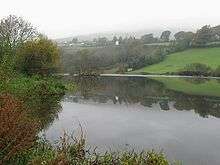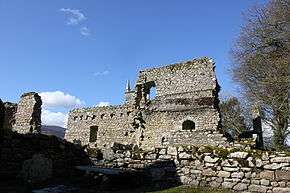Mo Ling
| Saint Moling | |
|---|---|
 Relief of St. Moling in St. Mary's and St. Michael's Church in New Ross | |
| Born |
614 Sliabh Luachra, Co. Kerry |
| Died | 697 |
Saint Mo Ling (614–697), also named Moling Luachra,[1] was the second Bishop of Ferns in Ireland and has been said to be "one of the four great prophets of Erin".[2] He founded a monastery at St Mullin's, County Carlow. His feast day is 17 June.
Life
According to a manuscript in the Royal Library, Brussels, Mo Ling was descended from Cathaoir Mór, King of Leinster. He is said to have been the illegitimate son of a wealthy landholder called Faelán the Fair, son of Feradach, and of Faelán's sister-in-law, Émnait. Ashamed of the pregnancy, Émnait fled home, traveling by night. She arrived at Sliabh Luachra in the midst of winter when the snow was said to be so deep that it reached men's shoulders. She gave birth to a son in the snow, whereupon a company of angels arrived and melted the snow around the child for thirty feet on every side.[3]
Émnait intended to kill the child but a white dove spread its wings around the baby, keeping him warm and protecting him from attack throughout the night. They were found the next morning by monks, who took them in and baptized the child Tairchell. When Tairchell was about sixteen years of age, he encountered a family of spectres on the road, but managed to escape by means of three fantastic leaps. The monk Collanach then gave him the name Mo Ling ('ling' meaning 'leap').[3]
There is a tradition that Mo Ling is Saint Myllin, who travelled to Wales, baptised people at the holy well in Llanfyllin, Powys, and founded the church there.[4]
Mo Ling was a monk at Glendalough and went on to become Bishop of Ferns. Bede describes Saint Mo Ling as a "good and wise man, excellently versed in the knowledge of the Scriptures". He died in 697 and is buried at St. Mullin's.[5]
St. Moling's Monastery

Saint Moling founded a monastery on the River Barrow. The monastery was said to have been built with the help of Gobán Saor, the legendary Irish builder. Over time a settlement grew up around it.
It is said that St Mo Ling established a mill there and dug a mile-long watercourse with his own hands to power it,[6] He is reputed to have been the first person to introduce rye into Ireland. He helped his people by distributing corn and meal during a particularly inclement summer. St. Mo Ling was a skilled boatman, passing quickly up the river Barrow to visit his friend Saint Laserian at Leighlin.
St. Mo Ling is linked with the folkloric character Suibhne Geilt [Mad Sweeney]. It is related that Suibhne Geilt, who went mad at the Battle of Moira (Mag Rath) in A.D. 634, afterwards travelled to Teach Moling. He was murdered there by Mongán, Saint Moling's swineherd. He was buried with great honour within the church by its founder and patron.

The original monastery was plundered by the Vikings around 824 and again in 951. An abbey was later built on the site. A 9th century high cross, showing the Crucifixion and a Celtic spiral pattern, stands outside the remains of the abbey. In a small square enclosure in the graveyard at St. Mullins is a stone altar with an arch overhead, where, according to tradition, Mass used to be celebrated in penal times. The churchyard lies in the shadow of an Anglo-Norman motte and contains a collection of eighteenth and nineteenth-century gravestones. During penal times, Mass was said in the structure in the graveyard. Over the altar is an aperture through which a warning could be communicated to the priest from a watcher positioned on the motte.[7]
St. Moling's Well
The first reference to a holy well at St. Mullins is to be found in the Annals of Friar Clyn (1348). In those times, the plague swept across Ireland and pilgrims visited the holy well in St. Mullins out of fear of the plague. They would circle the well in a clockwise direction, known as circumambulation, while reciting prayers. During the 19th century a pilgrimage to St Moling's well would take place twice a year on 17 June and 25 July. The well house was used for bathing children suffering from a variety of diseases.
Veneration
A pattern day is a day when people come together to perform pilgrimage at a holy well or at a saint's grave, usually on the saint's feast day, a tradition that can be traced back to early medieval times. Nineteenth-century accounts suggest there were originally two main pilgrimage days at St Mullins: the feast of St Moling on 17 June and the feast of St James on 25 July. Today the Patron or Pattern Day is held on the Sunday before 25 July. On 25 July prayers are said at St Moling's well and in the graveyard.
Legacy
The town of Monamolin in County Wexford is named after him,[8] as is the parish church in Ballycanew. Mullinakill, Co. Kilkenny; Timolin, Co. Kildare; Monamolin, Co. Wexford and St. Mullins, Co. Carlow, as well as St. Moling’s Wells, such as the one at Brosna, Co. Kerry are also named after him.[9]
Many churches were founded by Mo Ling, the most famous being St. Mullin's in County Carlow. Mo Ling dedicated a holy well at Ferns known as Maodhóg's Well in memory of St. Aidan, or Saint Maodhóg, the Patron Saint of the Diocese of Ferns.
According to the Annals of Ulster, Mo Ling died in 697 AD and his feast day is celebrated on 17 June.[1] The Patron Day takes place in Monamolin on the Sunday closest to this date.
John O'Donovan in his Ordnance Survey Letters of 1840 tells a story of Mo Ling crossing a small hill when an evil spirit annoyed him. He knelt on a rock to curse the spirit, leaving the impression of his knees on the stone. While there is no account of the stone today, it is said that the incident gave the name to the townland of Cloch na Mallacht (meaning "the stones of the curses").
See also
References
- 1 2 Ó Riain, Pádraig (2011). A Dictionary of Irish Saints. Four Courts Press. pp. 487–490. ISBN 978-1-84682-318-3.
- ↑ Healy, John (1912). "Chapter XVIII: The School of Glendalough". Insula Sanctorum et Doctorum Or, Ireland's Ancient Schools and Scholars (6 ed.). Dublin/London/New York: Sealy, Bryers & Walker/Burns & Oates/Benziger Brothers. p. 429. Retrieved 19 August 2014.
St. Moling has been set down as one of the four great prophets of Erin. The others are St. Patrick, St. Columcille, and St. Berchan of Clonsast
- 1 2 Stokes, Whitley (tr.), The Birth and the Life of St. Moling, London, 1907
- ↑ "St Myllin's Church, Llanfyllin". Mathrafal Deanery. Retrieved 19 April 2015.
- ↑ A Compendium of Irish Biography
- ↑ "St. Moling's Well", Enniskerry Local History
- ↑ "St. Mullins - ecclesiastical ruins", Carlow Tourism
- ↑ "St. Moling", St. Moling's Church, Monamolin
- ↑ "St. Moling's Trail", Carlow: Trails of the Saints
External links
| Wikimedia Commons has media related to Saint Moling. |
- Saint Moling et le Lépreux, a story about Moling and a leper, edited from UCD Franciscan Manuscript A9 and translated into French by Paul Grosjean S.J. at Thesaurus Linguae Hibernicae
Further reading
- Johnston, Elva (2004), "Mo Ling (d. 697)", Oxford Dictionary of National Biography (Online ed.), Oxford University Press, retrieved 2011-02-16